Real name Naseem Hamed Total fights 37 Height 1.64 m Nickname(s) Prince, Naz Name Naseem Hamed Parents Sal Hamed | Reach 64 in (163 cm) Role Professional Boxer Spouse Eleasha Hamed (m. 1998) Stance Southpaw Weight 58 kg | |
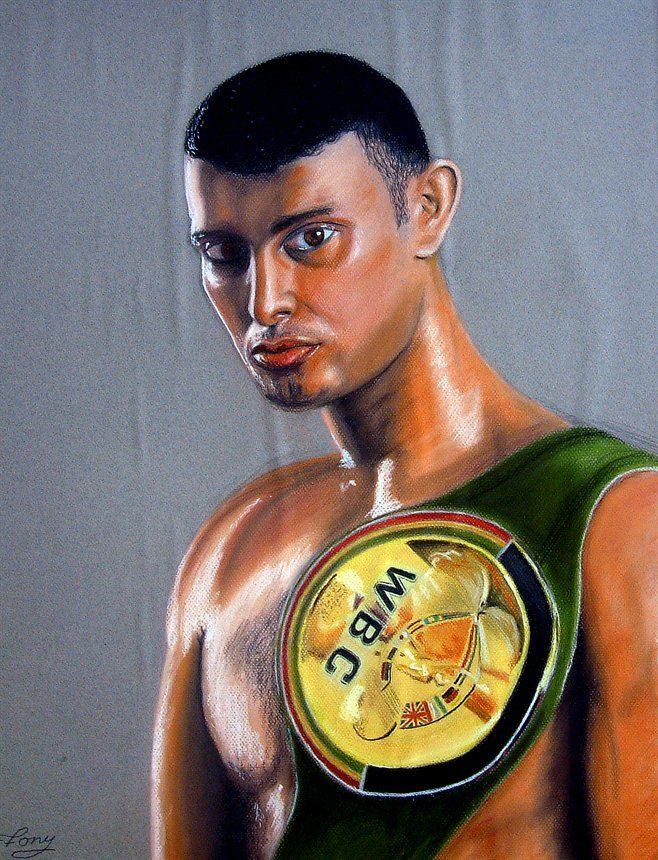 | ||
Rated at FeatherweightSuper BantamweightBantamweightFlyweight Siblings Riath Hamed, Nabeel Hamed, Murad Hamed Similar People | ||
Boxing greats prince naseem hamed
Naseem Hamed (Arabic: نسيم حميد; born 12 February 1974), commonly known as "Prince" Naseem or "Naz", is a British former professional boxer who competed from 1992 to 2002. He held multiple world championships at featherweight, including the WBO title from 1995 to 2000; the IBF title in 1997; and the WBC title from 1999 to 2000. He also reigned as lineal champion from 1998 to 2001; IBO champion from 2002 to 2003; and held the European bantamweight title from 1994 to 1995. Hamed is ranked as the third best British featherweight boxer of all time by BoxRec. In 2015 he was inducted into the International Boxing Hall of Fame.
Contents
- Boxing greats prince naseem hamed
- Muslim boxers prince naseem hamed
- Early life
- Early years
- Hamed vs Robinson
- Hamed vs Lawal
- Hamed vs Medina
- Hamed vs Johnson
- Hamed vs Badillo
- Hamed vs Kelley
- Other title defences
- Hamed vs Soto
- Hamed vs Bungu
- Hamed vs Sanchez
- Hamed vs Barrera
- Final fight vs Calvo
- Legacy and impact
- Personal life
- Controversy outside the ring
- References
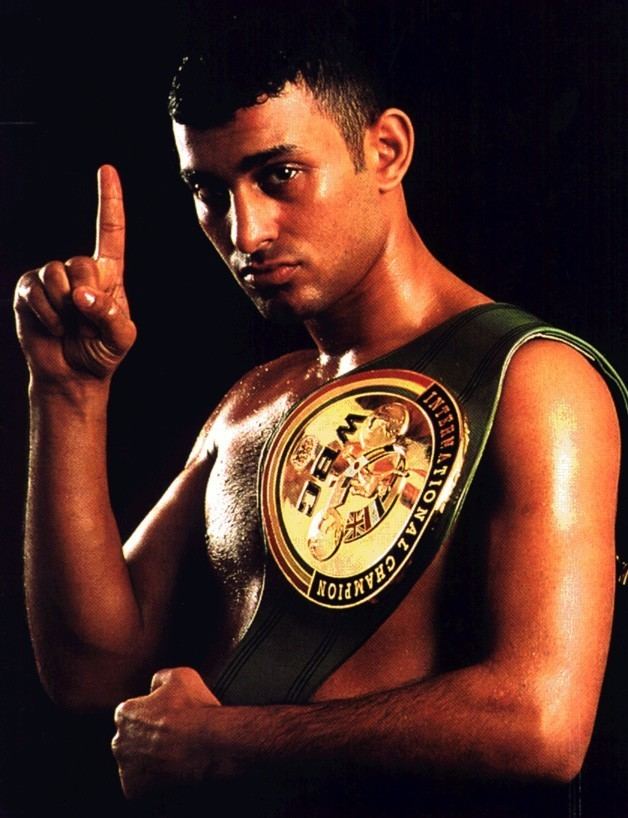
Hamed was known for his unconventional boxing antics and spectacular ring entrances which included entering the ring on a flying carpet, a lift, and a palanquin, as well as re-enacting the video of Michael Jackson's Thriller, and wearing a Halloween mask. He was also known for his front somersault over the top rope into the ring, his highly athletic and hard-hitting southpaw boxing style, and formidable one-punch knockout power; having finished his career with a knockout-to-win ratio of 84%.

Muslim boxers prince naseem hamed
Early life
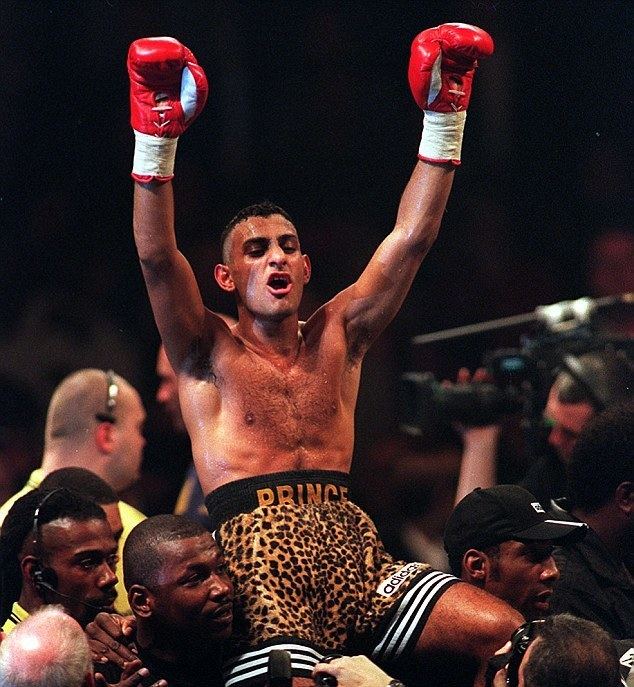
Hamed was born in Sheffield, Yorkshire, England to Yemeni parents, in 1974. A protege of Brendan Ingle's Wincobank gym, his talent and flashy southpaw style marked him out from an early age.
Early years

Hamed started boxing professionally at flyweight in 1992. He soon began rising through the ranks as he knocked out a series of opponents in the opening rounds. Age 20 he won the European bantamweight title, comprehensively beating the beleaguered Vincenzo Belcastro over twelve rounds. After one defence he won the WBC International super bantamweight title in 1994, overwhelming Freddy Cruz in Sheffield, whom he severely punished and stopped in six rounds. Hamed's popularity grew, his unorthodox style winning a large fan base and his boxing antics generating a large group of detractors. After signing for Frank Warren, Hamed, employing more spectacular entrances, knocked out better opposition in Enrique Angeles and Juan Polo Pérez, both within two rounds.
Hamed vs. Robinson

Later in 1995, after controversially being named the WBO #1 featherweight contender (despite never having boxed at that weight), Hamed moved up to face Wales' defending WBO champion Steve Robinson. After dominating the bout and scoring a knockdown in round 5, Hamed won the title when the referee stopped the fight in round 8 after Robinson was caught with a left hook that dropped him spectacularly. The fight was held in front of Robinson's home crowd at the rugby ground, Cardiff Arms Park, with rain pouring down on the fighters and the ring. This was also the first bout where Hamed badly injured his hand, a problem that would continue for the rest of his career.
Hamed vs. Lawal
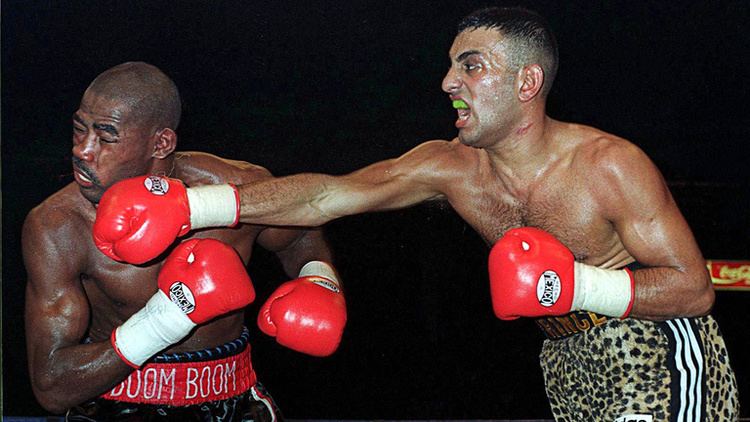
His first defence came against Austria based Nigerian, Said Lawal, who was instantly knocked down from Hamed's first punch, then stopped in just 35 seconds after being effortlessly dropped again. This was the fastest world title fight ever held in Scotland, much to the displeasure of the crowd. Hamed's second defence was against undefeated Puerto Rican Daniel Alicea. Televised in the United States by Showtime, Hamed was carried to the ring on a grand throne, something which Hamed later stated he was not comfortable with. After a fast, lively start from Alicea, Hamed suffered a surprising brief knockdown in round 1, the first of his career. However, Hamed won the fight in his favoured round 2 with two knockdowns, the second of which forced the referee to wave the fight off instantly.
Hamed vs. Medina
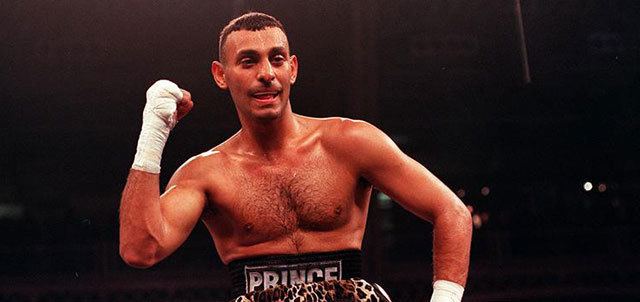
Hamed's next defence was in Dublin against former two-time world featherweight title holder Manuel Medina. After knocking Medina down heavily in round 2, Hamed struggled to finish the fight until finally knocking Medina down twice in the 10th round. Finally, at the end of round 11, Medina's corner withdrew him from the fight on the advice of the ringside doctor. Hamed revealed in his post-fight interview that he'd fought with a heavy cold. Medina would go on to have many more tough title fights, remarkably winning versions of the featherweight world title another three times. Hamed's next opponent was the 27–0 Remigio Molina of Argentina, who was stopped in two rounds.
Hamed vs. Johnson
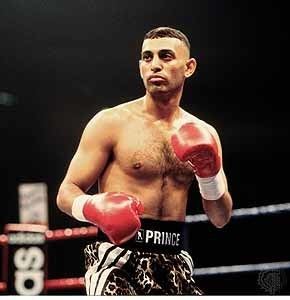
In February 1997, Hamed defeated long-time IBF champion Tom "Boom Boom" Johnson in eight rounds in a unification bout at the London Arena. After being constantly stunned and staggered from round 3 onwards, Johnson was finally dropped by a huge uppercut, then saved from further punishment by the referee. Hamed's first defence of both the WBO & IBF titles was a first-round KO of veteran British boxer and European champion Billy Hardy. Before the bout Hamed had correctly predicted he would win in round 1. The next defence was an easy two round win against a hugely outclassed Juan Gerardo Carbrera. Due to boxing politics involving the IBF's mandatory challenger, Hamed was soon forced to relinquish the IBF title.
Hamed vs. Badillo
In Hamed's hometown of Sheffield in October 1997, he produced one of the best performances of his career in defending his WBO title against Jose Badillo, whose corner entered the ring to stop the fight during round 7.
Hamed vs. Kelley
In late 1997 Hamed made his heavily hyped U.S. debut. His ceremonious arrival on the British Airways Concorde was covered by multiple media outlets. There, he and former WBC title holder Kevin Kelley fought in a highly entertaining bout. This fight marks something of a watershed in Hamed's career, as he was forced, for the first time, to abandon his hands-down style of fighting throughout the entire course of the bout, given the calibre of Kelley. Nonetheless, despite suffering three knockdowns himself, Hamed put Kelley down for a third and final time to win by a fourth-round knockout. This was his first of many fights on HBO.
Other title defences
In 1998, Hamed enjoyed victories over former three-time WBA title holder and then-lineal champion Wilfredo Vazquez (TKO 7), former WBC bantamweight title holder Wayne McCullough (W 12), and future IBF title holder Paul Ingle (TKO 11; no relation to Hamed's then-former trainer Brendan Ingle).
Hamed vs. Soto
In October 1999 at Joe Louis Arena, Detroit, Michigan, United States, Hamed defeated WBC featherweight champion Cesar Soto of Mexico over 12 rounds, adding the WBC title to his collection and unified the WBC & WBO titles. Hamed soon chose to relinquish his WBC title due to his commitment to being WBO champion.
Had Vazquez not been stripped by the WBA of his belt (the WBA did not want their featherweight title unified with the WBO), Hamed would have had the distinction of winning all four world titles in a division, something only Riddick Bowe had achieved by that point, at heavyweight.
Hamed vs. Bungu
In March 2000 at Olympia, Kensington, London, Hamed knocked out former undefeated long-reigning IBF super bantamweight title holder, Vuyani Bungu of South Africa. The fight was ended with a single straight left hand, in one of Hamed's most impressive performances and biggest victories.
Hamed vs. Sanchez
Hamed successfully retained his WBO title for the fifteenth and final time in August 2000 against Augie Sanchez at Foxwoods Resort, Mashantucket, Connecticut, United States via a devastating fourth-round knockout. Hamed broke his hand badly in the bout, and following surgery he spent half a year out of the gym, gaining 35 pounds in weight. Rather than face the unknown EBU Champion & WBO mandatory challenger István Kovács, Hamed relinquished his WBO title to pave the way for a Superfight with Marco Antonio Barrera.
Hamed vs. Barrera
Eight weeks prior to the fight, which took place at the MGM Grand Garden Arena in Las Vegas on 7 April 2001, Hamed was 40 pounds overweight. At the end of training camp he still didn't make the weight, and arriving in Las Vegas he spent the two days before the fight trying to shed 2 pounds in his hotel, by shadow boxing in steam rooms and running on the treadmill at 5am. Marco Antonio Barrera had "trained like a monk" in Big Bear, California, while Hamed trained in Bing Crosby's old house. Emanuel Steward had arrived to oversee the last two weeks of Hamed's training, including sparring, and was worried immediately. He had seen Barrera look razor sharp only a few months before in a stoppage win in Las Vegas, and watched Hamed look ragged in sparring with young Mexicans hired by the camp where his timing was woeful. The fight was also for the International Boxing Organization World featherweight title.
Hamed lost to Barrera via a unanimous decision (111-116, 112-115, 112-115), losing his Lineal championship. Hamed's record at the time was 35–0 and he was a heavy favourite with bookmaker's odds of 1/8. Having re injured his hand in training, Hamed took 40 minutes to come to the ring due mostly to not being happy with the gloves and having his hand wraps redone multiple times and didn't vault the rope while entering the ring as he normally did due to the pain in his hand and still not being happy with the gloves. After being wobbled in Round 1, Hamed gained focus and was connecting a lot of punches however as the fight wore on he could not hit Barrera with his trademark lefts as much as in previous bouts as the Mexican boxer was equally quick and was not fighting defensively. His game plan was to circle around Hamed counter-clockwise to negate Hamed's powerful left hand punch. On one occasion early in the fight, Barrera grabbed Hamed around the waist to which Hamed then pulled Barrera and they both fell to the ground where Barrera threw a right jab, leading to a warning from referee Joe Cortez. There were also several unchecked headbutts from Barrera. In the 12th and final round, Hamed, still looking for the knockout punch, missed wildly with a left hand, resulting in Barrera taking the opportunity to trap Hamed in a Half Nelson hold and force his head into the turnbuckle, resulting in a point being deducted by referee Joe Cortez. The flagrant (and memorable) foul, with the corner camera catching an infuriated-looking Barrera ramming Hamed into the corner post with conviction, the slow-motion replay turning it into one of the era's most memorable moments. Ultimately, Barrera was more versatile and threw sharp, effective combinations en route to a unanimous decision, the first and only loss of The Prince's career.
Final fight vs. Calvo
On 18 May 2002 at London Arena, Docklands, London, Hamed returned to the ring for what turned out to be his final boxing match, against the European champion Manuel Calvo (33 wins, 4 losses, 1 draw) for the International Boxing Organization World featherweight title. Hamed was booed by the 10,000 fans as he won unconvincingly on points after 12 rounds looking sluggish and uninterested. The judges scored the fight 120-110 and 119-109 (twice). In a post-fight interview with Ian Darke, Hamed assured a quick return to the ring, which ultimately never happened. For years, Hamed didn't confirm whether he'd retired or not; there were talks of several fights in the UK and in the US, included Hamed's brother and manager, Riath, speaking to HBO about a potential fight with Michael Brodie.
In an interview for BBC Radio Sportsweek, Hamed said that his retirement was largely due to chronic problems with his hands, including multiple fractures as well as surgery.
Legacy and impact
Hamed's boxing career was seen by many experts in the sport as one of massive potential. Frank Warren, the boxing promoter, once said of Hamed: "I think at one stage he was the most exciting fighter that I'd ever been involved with. At one stage, in the early part of his career, he could have gone on to become one of the great fighters. But that disappeared when he didn't fight as regularly as he should have done, when he was cutting corners on his training. It just didn't work out for him from that point on."
Moreover, commentators have pointed out that Hamed's ability should have propelled him to achievements that would have given him legendary status, but that his noted dislike of the long hard training camps and long periods away from his family hindered this.
As popular lower weight fighters like Oscar De La Hoya and Kostya Tszyu moved into the mid-weight classes and the Mexican champion Julio César Chávez declined, Hamed and Arturo Gatti filled the void. Hamed's boxing antics made him the new poster-boy for lighter-weight boxers and his charisma attracted a large number of fans. In 2002 the UK public voted Hamed's victory over Kevin Kelley on the list of the 100 Greatest Sporting Moments.
Hamed was referenced by hip-hop artist Nas in the song "You Won't See Me Tonight", with the lyrics "I can't forget how I met you, you thought I was a boxer/ Prince Naseem, but I'm a mobster, Nas from Queens". Hamed himself recorded a song with hip hop group Kaliphz called "Walk Like a Champion", which reached number 23 in the UK Singles Chart in 1996.
British boxing pundit Steve Bunce stated on 15 March 2008 edition of BBC panel show Fighting Talk that Hamed was the greatest British boxer of all time. World Boxing, a sister publication of the more famous The Ring Magazine, ranked Hamed as the 11th greatest British boxer of all-time. The Ring also ranked Hamed as the 46th greatest puncher of all-time. Journalist Daniel Fletcher, in a 10-year anniversary commemoration of the end of Hamed's career, "Requiem for Naseem", referred to Hamed as "the most talented fighter to ever live", one of history's première featherweights and British boxers, and that while his career ended prematurely at the age of 28, he still managed to dominate his weight class for six years and boast some formidable achievements.
Hamed is part of the 2015 class for the International Boxing Hall of Fame.
Personal life
Hamed is a Muslim, and frequently recited the Takbir out loud before his fights.
Controversy outside the ring
On 2 May 2005 Hamed was involved in a 90-mph three-car collision at Ringinglow Road, Sheffield, while driving his £300,000 silver McLaren-Mercedes SLR. He was arrested on 3 May, released on bail and later charged at Sheffield Magistrates Court on 3 December.
On 31 March 2006 Hamed entered a plea of guilty and was warned he could face jail by a judge at Sheffield Crown Court. The Recorder of Sheffield, Judge Alan Goldsack, adjourned the case until 12 May to allow pre-sentence reports to be prepared. The court heard how the man in the car Hamed hit, later revealed as 38-year-old Anthony Burgin, who had attended a number of previous hearings, was unable to come to court because he was in hospital for further treatment. His wife Clare was also injured.
On 12 May the court heard in a sentencing hearing how Hamed had been anxious to impress businessman Asif Goro, who was a passenger in the McLaren-Mercedes at the time of the crash. Hamed was showing what his car could do when he crossed a solid white line at a speed of at least 90 mph and crashed head-on into a Volkswagen Golf that emerged from a dip in the road. Hamed's car then hit a second vehicle, the Ford Mondeo he had been trying to overtake. Mr. Burgin, the driver of the Volkswagen Golf, was very seriously injured, breaking every major bone in his body and suffering bruising to the brain. Hamed escaped unhurt.
Hamed was sentenced for 15 months after pleading guilty at an earlier hearing. He was also given a four-year driving ban. Judge Alan Goldsack told Hamed: "I find it astonishing that the DVLA has not been prepared to cooperate with the prosecution to give them details of your earlier offences – apparently on human rights grounds." The DVLA's decision led to Hamed being sentenced without the judge being told he had previously been banned for a year for driving a Porsche at 110 mph on the M1 in Derbyshire. It was also revealed that Hamed had three other previous convictions for speeding offences, details of which the prosecution had to find from court records.
Hamed was granted an early release and left prison on 4 September 2006 after serving 16 weeks of the 15-month sentence. Hamed was placed under Home Detention Curfew for the remainder of his sentence, and monitored by an electronic tag.
Anthony Burgin, the driver whom Hamed collided with, said: "I am shocked that after such a serious accident Mr Hamed has been released after less than four months." After recommendation from the Honours Forfeiture Committee, Hamed was later stripped of his MBE, annulled as a consequence of the conviction.
There was also a civil court case rumoured to cost Hamed up to £1 million plus legal costs, as Burgin was deemed unable ever to work again.
Burgin was later arrested and charged with dangerous driving for an incident alleged to have involved Eleasha Hamed (the wife of Naseem) on 19 April 2007. Burgin pleaded not guilty, and appeared in court on 17 March 2008, following which he was cleared of charges.
